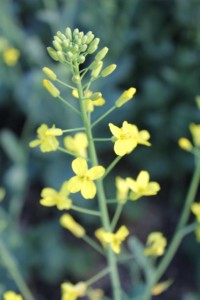 By Rob Rynning
By Rob Rynning
I farm in the very northwest corner of Minnesota with my brother and nephew. We have grown canola since 1994 and gained many benefits from this very interesting and beautiful crop.
Rotation, Rotation, Rotation
The first and most obvious advantage to growing canola has been its great rotational benefit. In 1993, we had an explosion of Fusarium head blight disease in our wheat and barley crops. The early to mid-1990s were very trying for small grain farmers in the Midwest and much of Canada’s small grain-growing regions. Raising small grains year after year on the same ground with very wet growing seasons but without chemicals to deal with resulting fungal diseases caused huge losses. When we introduced canola into our rotation, we saw an immediate positive response in our wheat crops the following year.
In the early years of the Fusarium outbreak, we only had a few crop options to rotate into our system: tame mustard or small acreages of soybeans. Some of our neighbors mixed in sunflowers or sugar beets. But all of these crops were grown on rather limited acreage and soybeans had very limited, marginally yielding varieties. With canola, we found a crop that did very well in our climate and helped us fight several diseases, especially Fusarium in our small grains.
Canola has also turned out to be perfect in rotation with winter wheat. It is cut at harvest to 8-12 inches, leaving a wonderful stubble in which to directly seed winter wheat. Those stalks work very well in stopping and holding snow to help protect wheat from cold winter temperatures.
Soil Health and Wealth
Another big benefit of growing canola is improved soil health. The soil tilth in the fall after the harvest and into the next season is fantastic. The large tap root and extensive root structure of canola plants open and even puff up the soil, almost like mulch has been added to it. Direct seeding into canola stubble in the fall usually makes a great seed bed. If the ground is worked with minimal tillage, there are usually ample stalks and chaff left on top of the soil to protect it from wind and water erosion. Many canola growers have also found that canola ground can absorb water very well because of its superior roots that help open paths in the soil for water to flow through.
 In addition to improving soil health and the crops that follow it, canola can be very lucrative. Many farms in our region have had good success growing it as a cash crop. The advent of hybrid varieties and herbicide-tolerant types have helped make canola an excellent fit into many operations. The assertive, vigorous growth of hybrid varieties have helped make canola much more productive and consistent than it used to be. Also, herbicide-tolerant types have helped canola fit into most weed control systems. The development of pod shatter-resistant varieties has made harvesting much easier, removing the need to swath and enabling straight harvesting.
In addition to improving soil health and the crops that follow it, canola can be very lucrative. Many farms in our region have had good success growing it as a cash crop. The advent of hybrid varieties and herbicide-tolerant types have helped make canola an excellent fit into many operations. The assertive, vigorous growth of hybrid varieties have helped make canola much more productive and consistent than it used to be. Also, herbicide-tolerant types have helped canola fit into most weed control systems. The development of pod shatter-resistant varieties has made harvesting much easier, removing the need to swath and enabling straight harvesting.
Canola can take more attention to manage than some competing crops, say soybeans, but it can also be very rewarding. If managed well, canola can be a very good cool season risk offset for crops that develop at different times. It may also be much more conducive to cool and/or different seasonal wet periods. We use it alongside soybeans to spread out weather risks; a cool summer will benefit canola while a hot summer will help soybeans. Canola has been one of our favorite crops to grow over nearly three decades. It continues to be improved genetically and has been increasing in acreage in northern tier states as a result. If it works in growers’ climates, I encourage them to give it a try.
Rob Rynning is a canola grower in Kennedy, Minnesota and past-president of the U.S. Canola Association.